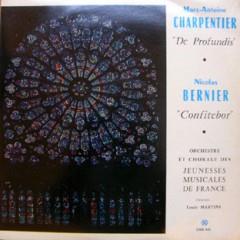Marc-Antoine Charpentier: De Profundis - Nicolas Bernier: Confitebor tibi Domine (1955)
Marc-Antoine Charpentier: De Profundis - Nicolas Bernier: Confitebor tibi Domine (1955)

1. Marc-Antoine Charpentier - De Profundis (Tome 20) 2. Nicolas Bernier - Confitebor tibi Domine (Psaume CX) Martha Angelici (soprano) Jean Archimbaud (sopraniste) Jeannine Collard, Yvonne Melchior (contralto) Jean Giraudeau, Pierre Giannotti (tenor) Louis Noguera (bass) Chorale des Jeunesses Musicales de France Orchestre non identifié, Henriette Puig-Roget (organ) Louis Martini (direction) Edition originale : 33t Pathé DTX 158 Réédition : 33t Club National du Disque CND 562
Marc-Antoine Charpentier (c.1634 - 1704), a French composer (from Paris), who studied in Rome with Carissimi. On returning to France he was opposed by his Paris contemporary Lully, but nevertheless won considerable esteem. A prolific composer, he was more appreciated for his church music than his secular compositions. Charpentier was favoured by the Dauphin and the Jesuits who appointed him music master at their St. Louis church and later at the Sainte-Chappelle.
De Profundis Clamavi is one of seven settings by Charpentier, this is the most extended of them and was written for the funeral ceremonies of Marie Therese, Louis XIV's wife. There were a number of services and it is not certain for which Charpentier's motet was written. It is on a large scale, with a double solo quartet and six-part choir, and flutes added to the strings. The work opens with a prelude which sounds very French, with great elan. There follows a very plangent movement for the double quartet of soli, full of overlapping lines, before the full choir joins in.
Little is known of the early life of Nicolas Bernier (1665 - 1734); at some time he studied in Italy, and was a pupil of Caldara. Returning to France, he established a reputation quite soon, for although he was unsuccessful in his bid for the post of maître de musique at Rouen cathedral in 1693, he won that position at Chartres the next year. In 1698 he was appointed to the prestigious Parisian position of maître at St Germain l'Auxerrois, the parish church of the Louvre. His big break came in 1704 when he succeeded Charpentier as maître at the Sainte-Chapelle, the chapel of the old royal palace in the Cité. This was the second most important musical post after that of sous-maître at the Chapelle Royale at Versailles. Then in 1724 the post at Versailles, where Lalande had reigned supreme for 9 years, was divided once more between four musicians; Lalande himself and three others, to wit Bernier and his friends Campra and Gervais. As well as the French cantatas, Bernier wrote many motets for small ensembles of voices and instruments, as well as Grands Motets for the larger resources of Versailles, as Lalande had done before him.
Bernier was among the first to write French cantatas, together with Morin, Stuck ("Batistin") and Campra. Bernier's earliest published cantatas appeared in Paris in or soon after 1703, and may have been the first to appear in print.In 1711, Bernier published some works in his Troisième livre des cantates françoises. From this collection comes a motet Confitebor tibi Domine.
download (mp3 @320 kbs):
yandex 4shared mega mediafire uloz.to cloudmailru uptobox ge.tt








